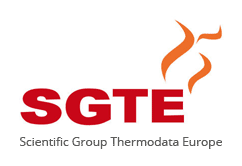- SGTE - Scientific Group Thermodata Europe
- Thermochemical Databases
- SGTE Solution Database
SGTE Solution Database (SGSOL)
The SGTE Solution database contains data for the liquid phase and various crystalline phases of the pure elements in addition to over 400 binary, ternary and quaternary alloy systems. The data have been derived by a process of critically assessment taking all the relevant experimental data, eg enthalpies of mixing, partial pressures, solubilities, thermal arrests etc and then using them to derive a small number of coefficients representing how the thermodynamic properties of the system change with temperature and composition. These coefficients can then be used not only to calculate the thermodynamic properties and the phase diagram for that particular system but they can also be used in combination with other similar datasets to make predictions of thermodynamic properties and phase equilibria for more complicated systems with many components. Inherent in this approach is the use of reliable and well tested models to represent the properties for subsystems and to allow their extrapolation into higher order systems.
The data have been generated either by SGTE members or taken from critical assessments published in the open literature in journals such as CALPHAD, Journal of Phase Equilibria and Diffusion, Zeitschrift für Metallkunde, Journal of Alloys and Compounds and Journal of Electronic Materials.
The database was completely revised in 2001 and is updated annually.
The database covers a wide range of material types including steels, superalloys, aluminium alloys, semiconductors, solders and brazes, nuclear materials ....
Typical applications of the database would be:
- modelling the solidification of commercial alloys
- development of new materials
- predicting heat treatment cycles
- control of microstructure
- safety predictions in hazardous environments
- development of new processing routes
- chemical and physical vapour deposition
The database is fully compatible with the Substance database.
Contact person:
Alan Dinsdale, MISiS, Moscow, Russia












